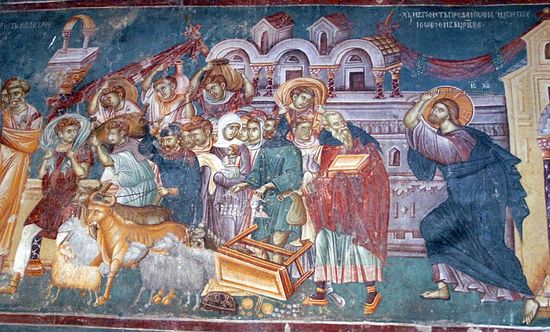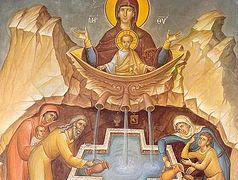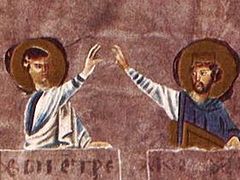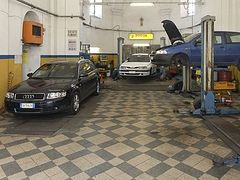After this he went down to Capernaum, he, and his mother, and his brethren, and his disciples: and they continued there not many days. And the Jews' passover was at hand, and Jesus went up to Jerusalem. And found in the temple those that sold oxen and sheep and doves, and the changers of money sitting: And when he had made a scourge of small cords, he drove them all out of the temple, and the sheep, and the oxen; and poured out the changers' money, and overthrew the tables; And said unto them that sold doves, Take these things hence; make not my Father's house an house of merchandise. And his disciples remembered that it was written, The zeal of thine house hath eaten me up. Then answered the Jews and said unto him, What sign shewest thou unto us, seeing that thou doest these things? Jesus answered and said unto them, Destroy this temple, and in three days I will raise it up. Then said the Jews, Forty and six years was this temple in building, and wilt thou rear it up in three days? But he spake of the temple of his body. When therefore he was risen from the dead, his disciples remembered that he had said this unto them; and they believed the scripture, and the word which Jesus had said (Jn. 2:12-22).
We remember these events at the beginning of the Lord’s ministry and on the eve of His passion on the Cross. Christ became angry and admonished the Temple merchants with the help of a whip. He wants us to learn to have such deep reverence for our stone churches as for the Church made of living stones, which is the mystical Body of Christ. The indignation of the Lord is nowhere else manifested with such force. There are among us those “preachers of love” who say that no anger is acceptable in the Church, and they are even offended by the Lord’s actions. But Christ, we see, overturns the tables, scatters the coins, and drives the merchants out of the Temple together with their livestock, as an impurity. “Where are you, you mercantile souls? This is not a market, not a house of trade!”
Why does the Lord show such zeal for the Temple? Is it really to protect its beauty? This Temple, just rebuilt by Herod, was large and magnificent. 600 priests and 300 Levites participated in the services during the high holidays. In the center of the square, amongst many courtyards, one of which was accessible to Gentiles, was found the sanctuary. It consisted of two rooms: the Holy Place, where only priests could go, and where were the incense offerings, the golden seven-branched candlestick, and a table for the showbread, and further, divided by a double veil, was the Holy of Holies. In the first Temple, built by Solomon, the Ark of the Covenant was kept here, with the tablets of the Law, delivered by God to Moses. The Ark disappeared with the destruction of the Temple in 587 BC, but the Holy of Holies remained the sacred place of the presence of God. Only the high priest had the right to enter there once a year—on the feast prophesying of atonement. This is why the Lord becomes angry! The ringing of money in the Temple, near the Holy of Holies, was an affront to the greatness of God. Christ tell us not to fear to assert our right to protect the sacred objects of the Church. “Here you must imitate Me,” He as if addresses us. “A church is My Father’s house, and I will not allow anyone to turn it into a den of thieves.”
How many strokes of the Lord’s whip would be proper for those who ravaged and desecrated our churches, turning them into clubs, cafes, storage centers, public toilets—into houses of their trades?! Truly they have received blows from the Lord in full measure. How full a measure they and those who today publicly mock our sacred objects will receive.
The Lord reminds us how dangerous is every impiety. From it is gradually created an atmosphere of wickedness—such that, according to Scripture, “the man of lawlessness” will be able to sit in the Temple, representing himself as God. The Lord permitted there to be the cleansing firestorm of 1917, destroying our churches, to give us time for repentance. But how little we learned! If only every one of us could say, following the Lord, the zeal of thine house hath eaten me up (Ps. 69:9).
Where there is no reverence for churches, there can be no true relationship with the Church of God. But the Temple, of which the Jews were so proud, is only a stone temple, and what’s more—built by a pagan desiring to entice this haughty people. “Destroy it,” says the Lord (and this will happen under Emperor Titus in the year 70 AD). “Its value is relative, for the genuine temple is that which I will raise up on the third day.” Even the disciples didn’t understand the Lord’s words then, because He spoke of His Body, which was to rise again on the third day.
The Lord says that the true temple, worthy of unending reverence, is the humanity of Christ, which became the ark of His Divinity. The Word became flesh, and His body is the true Holy of Holies of the Temple. For in him dwelleth all the fulness of the Godhead bodily (Col. 2:9). The Body of Christ, which we receive in the Eucharist and which is present in the tabernacles on the altars of our churches, should fill us with the fear of God and unending awe. And conversely, any irreverence or simply indifference in the face of this great mystery should evoke a holy anger in the heart of a Christian, incomparably more righteous than against the wickedness in the Jerusalem Temple.
The new temple, worthy of veneration, is not just the human nature of Christ, but the whole people of God, grafted onto Him and nourished by the Divine life radiating from Him to every member of His mystical Body. The whole Church, the Body of Christ is the new temple, of which churches of stone are but a pale image. It is composed of all baptized people seeking life according to the will of God. Despite the imperfections, sins, and infirmities of its children, the Church—the abiding of God among men—is the sign of His presence in the world. It was not created by holy men, but was created to make men holy, because its Creator is God, Who became one of us through the Most Pure Virgin.
On the feast of the Lord’s Pascha, rejoicing in that miracle that the Church performs in the world, let us take care for our inner purification, to be her children in truth. Throughout all of Bright Week we hear, “As many as have been baptized into Christ, have put on Christ.”1 Every Christian is a temple of God. The body of every baptized child is a receptacle of the presence of Christ. Christ is born in every newly-baptized babe. With what reverence should our children, and we with them, ascend to God, bearing in our bodies the living presence of the resurrected Christ, received in Baptism. The day is coming when our bodies, these temples of the Holy Spirit, will return to the earth. The time is coming when the earthly Church, with its priesthood and sacraments, will cease to exist, having fulfilled its mission. There will be no more Divine Eucharist. Our world will be destroyed, and all the marvelous churches will become nothing. But in the heavenly and eternal city there will remain but one temple, which is God Himself. We will be lead into it as children of God, and our lives will be unending communion of the joy of the Resurrected Christ.




